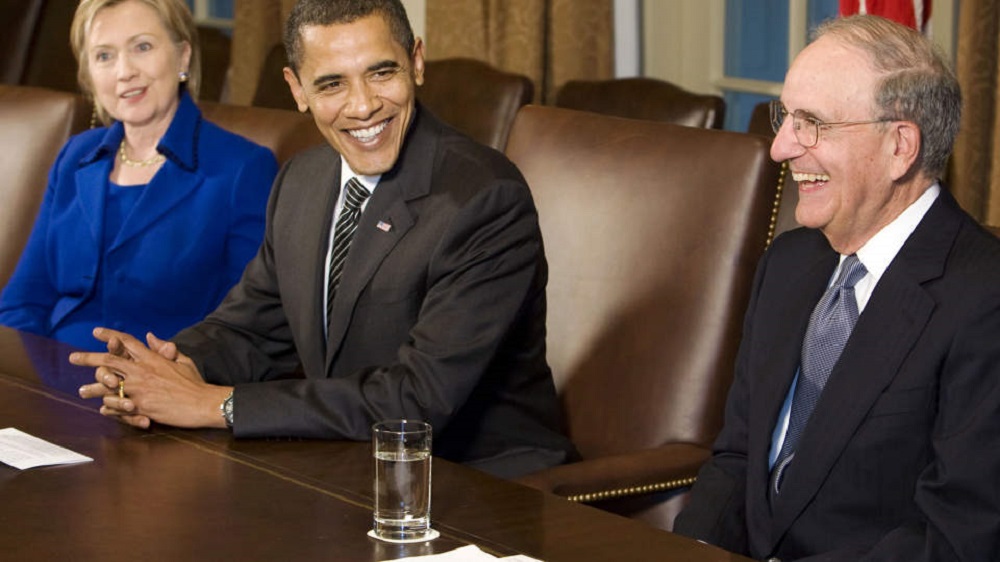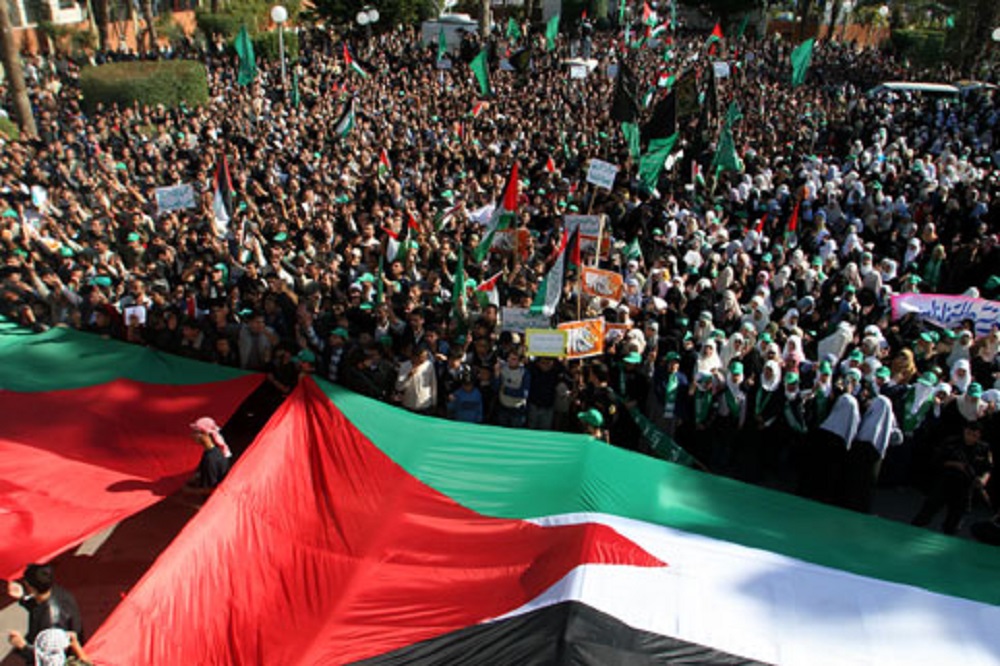Advice for George Mitchell
With the recent appointment of former U.S. Senator George Mitchell as the Obama administration’s special Middle East envoy, discussion will inevitably turn to Mitchell’s personal involvement in the Belfast “Good Friday” Agreement of April 1998 that involved the decommissioning of Irish Republican Army (IRA) weapons, and the commitment of the IRA to pursue its political goal of the reunification of Northern Ireland with Ireland by peaceful means.
In 2003 and later in December 2008, Mitchell shared his vision for the Middle East conflict based on his Belfast experience: “There is no such thing as a conflict that can’t be ended,” he said. He is about to discover that you cannot make peace with those who seek your destruction because partnerships with Islamist regimes are Faustian bargains that are doomed to failure.
The developing field of “conflict resolution studies” in American and European universities seeks to apply lessons learned from political conflicts in one region of the world to conflicts in other regions often without regard to cultural and religious distinctions. For that reason, Mitchell’s appointment will no doubt lead academics, journalists, diplomats and American and European think-tanks to begin drawing parallels between Britain and Ireland negotiating with terrorist organizations like the IRA and the need for Israel to follow the British/Irish example by commencing negotiations with Hamas.
The Europeans are of the view that establishing a dialogue with Hamas will lead it to change its ideology, cause it to renounce terrorism as a tactic, moderate its positions, stop its suicide bombings, relinquish its weapons, and lead to its recognition of Israel – none of which has any historical precedent in dealing with radical Islamists. And therein lies the problem.
This approach fails to take into account that Hamas and the IRA evolved in completely different historical, geo-political and cultural environments. First and foremost, Gaza and the West Bank are not Northern Ireland, Hamas is not the IRA, and there are certain basic realities that are unique to the region. The difficulty with the traditional “conflict resolution” approach was summed up recently in an article by Walid Phares concerning Guantanamo Bay detainees released in 2007 who have now rejoined the ranks of al Qaeda: “Jihadism as an ideology does not respond to the political culture of democracy nor are the indoctrinated Jihadists impacted by the moral and legal debate within what they see as the sphere of the infidels.”
Thus, the argument suggesting dialogue with Hamas is rooted in the false assumption that any two parties with diametrically opposing views can always achieve some sort of compromise. If that is the principle upon which future discussions are to be based, his initiative will fail and there will be tragic consequences.
Although most IRA members were Catholic, the IRA’s platform was essentially political in nature and revolved around throwing the British out of Northern Ireland and the unification of Northern Ireland with Ireland. The ideology of Hamas, however, has always been defined in religious terms that are not subject to influence, change, discussion or compromise. Its motto declares that “Allah is our goal, the Quran is our Constitution, the Prophet is our leader, jihad is our way, and death in the service of Allah is the loftiest of our wishes”. These are not negotiable issues.
In Hamas’s worldview, there is no division between its political and religious objectives thereby making any significant change unlikely. Nor is there any concept of co-existence with Israel or even Jews in a broader sense. Hamas could agree to a hudna (calm) for fifty years, but there will be no recognition of Israel or a cessation of the struggle against it. If Hamas was ready to act pragmatically, it would no longer be Hamas. Thus, talk of a “two state solution” is meaningless. Hamas’s sole rationale for existence has been and remains the conquest of Israel and the subjugation of its citizens to shari’a – a throw-back to the d’himmitude status under which infidels lived in Andalusian Spain a millennium ago. As a consequence, Hamas waged war on the Oslo peace process in the 1990s, and its campaign of suicide bombings against Israel helped to derail that process and later the Mitchell Plan which failed due, in large measure to the Palestinian Authority’s inability or unwillingness to stop Palestinian terrorist attacks or incitement against Israelis and Arafat’s failed attempts to smuggle Iranian weapons into Gaza aboard the Santorini (2001) and the Karine-A (2002).
Moreover, the Hamas Charter adopted in 1988 defines the land of Palestine (including Israel) as “an Islamic Waqf” (trust territory) consecrated for future Muslim generations and adds: “Until the Day of Resurrection, no one can renounce it or part of it, or abandon it or part of it” (Article 11). The Charter states “Israel will arise and will remain in existence only until Islam eliminates it as it has eliminated its predecessors.” Its Charter also defines the enemy explicitly as the Jewish people. In essence, Hamas cannot recognize Israel’s right to exist without betraying its own raison d’etre.
In contrast, the IRA sought reunification with Ireland, never challenged Britain’s right to exist either politically or religiously, and did not adopt ethnic cleansing as part of its objectives. The conquest and subjugation of Britain never formed part of its political let alone religious agenda.
And there are other distinctions that Mitchell had best consider prior to transposing his conflict resolution theories onto Hamas.
First, separate and apart from bestowing legitimacy on a radical Islamic organization and conveying to its leaders the impression that Americans are just useful idiots, Hamas’s use of violence (“armed resistance”) is perceived by the majority of Palestinians not as a liability (as it eventually came to be seen in the case of the IRA) but as a positive political attribute.
Second, after the IRA ceasefire of 1994, specific ground rules for participation in negotiations were established and a code of conduct agreed to between the parties – a commitment by all sides to abide by “democratic and exclusively peaceful means” for resolving political issues and the “total disarmament” of all Catholic and Protestant paramilitary groups. The reality is that in Northern Ireland, Sinn Fein, the political party that is affiliated with the IRA, did not enter the negotiations until after 15 months had elapsed in the negotiations, and only then because they met two central conditions that had been established. The first was a ceasefire, and the second was a publicly stated commitment to democratic and exclusively peaceful means of resolving political issues; a commitment to renounce for themselves and to oppose any efforts by others to use force or threaten to use force to influence the course or the outcome of the negotiations; and finally a commitment to agree to abide by the terms of any agreement reached in negotiations and to resort to democratic and exclusively peaceful methods in trying to alter any aspect of that outcome with which they may disagree.
Insofar as Hamas is concerned, establishing principles governing the conduct of negotiations by infidels like Mitchell are inconsistent with its religious ideology, its modus operandi, and its jihadist creed. Hamas’s Charter (Article 13) emphatically rules out any possibility of a peace process or the use of mediators to achieve a compromise since there can be no compromise with its jihad. In effect, there is nothing to negotiate with Israel other than its destruction and ultimate submission to Islam. Despiteour almost sacredbeliefthat negotiation and diplomacy can resolve any conflict, we are confronting the same theology that represents theessence of our global conflict with radical Islamists.
The only characteristic the IRA and Hamas share in common is that both are terrorist organizations. But that is where the similarity ends. Due to the nature of the IRA’s “war” and its loss of support following the Omagh bombing on August 15, 1998, it became possible to negotiate peace and the decommissioning of its weapons. Hamas however is sworn to the destruction of Israel as a religious imperative so any attempt to negotiate that away would be futile.
As John Bew and Martyn Frampton wrote in their August-September 2008 dissertation for the Jerusalem Center for Public Affair (“Talking to Terrorists: The Myths, Misconceptions and Misapplication of the Northern Ireland Peace Process”): “So long as (Hamas) exerts its stranglehold on its own (Palestinian) community, and refuses to consider the recognition of Israel, there is a danger that negotiating with the organization will strengthen its position against more moderate alternatives, as well as bolstering its belief that it can achieve its ultimate objectives.”
Despite the belief of President Obama and his advisers that not talking to our enemies is a mistake, and given the pressure the Europeans can be expected to exert on Mitchell to negotiate with Hamas, the Obama administration had best tread carefully before engaging an organization that is the ideological cousin of al Qaeda and the Palestinian offspring of the Egyptian Moslem Brotherhood. Granting Hamas legitimacy and access to the prerogatives of state power in conjunction with the Palestinian Authority will prove to be a costly strategic error for all parties concerned – except Hamas, Hezbollah, Syria, Iran and its terroristproxies throughout the Middle East.
On January 26th, Osama Hamdan, Hamas’ representative in Lebanon said: “The Palestinian Authority must end its peace talks and security coordination with Israel if it ever expects to reconcile with Hamas.” That being the case, the best President Obama can hope for is to degrade Hamas to the point where its power and credibility are severely damaged, and to establish an international body with accountability, transparency and unprecedented oversight responsibilities to insure that the billions of dollars set to flow into Gaza reconstruction contribute directly to Palestinian life, and not end up in the political coffers of the corrupt and vastly unpopular Palestinian Authority* or Islamist Hamas which will see a national “reconciliation” government as a means to gain international recognition, reap the billions of dollars of international aid, and rebuildits offensive capabilities against Israel using the Fatah-led PA as a cover while subverting Fatah control on the ground.
*For details, see – Dan Diker and Khaled Abu Toameh, “Can the Palestinian Authority’s Fatah Forces Retake Gaza? Obstacles and Opportunities, Institute for Contemporary Affairs-Jerusalem Center for Public Affairs”, No. 569, January-February 2009.



